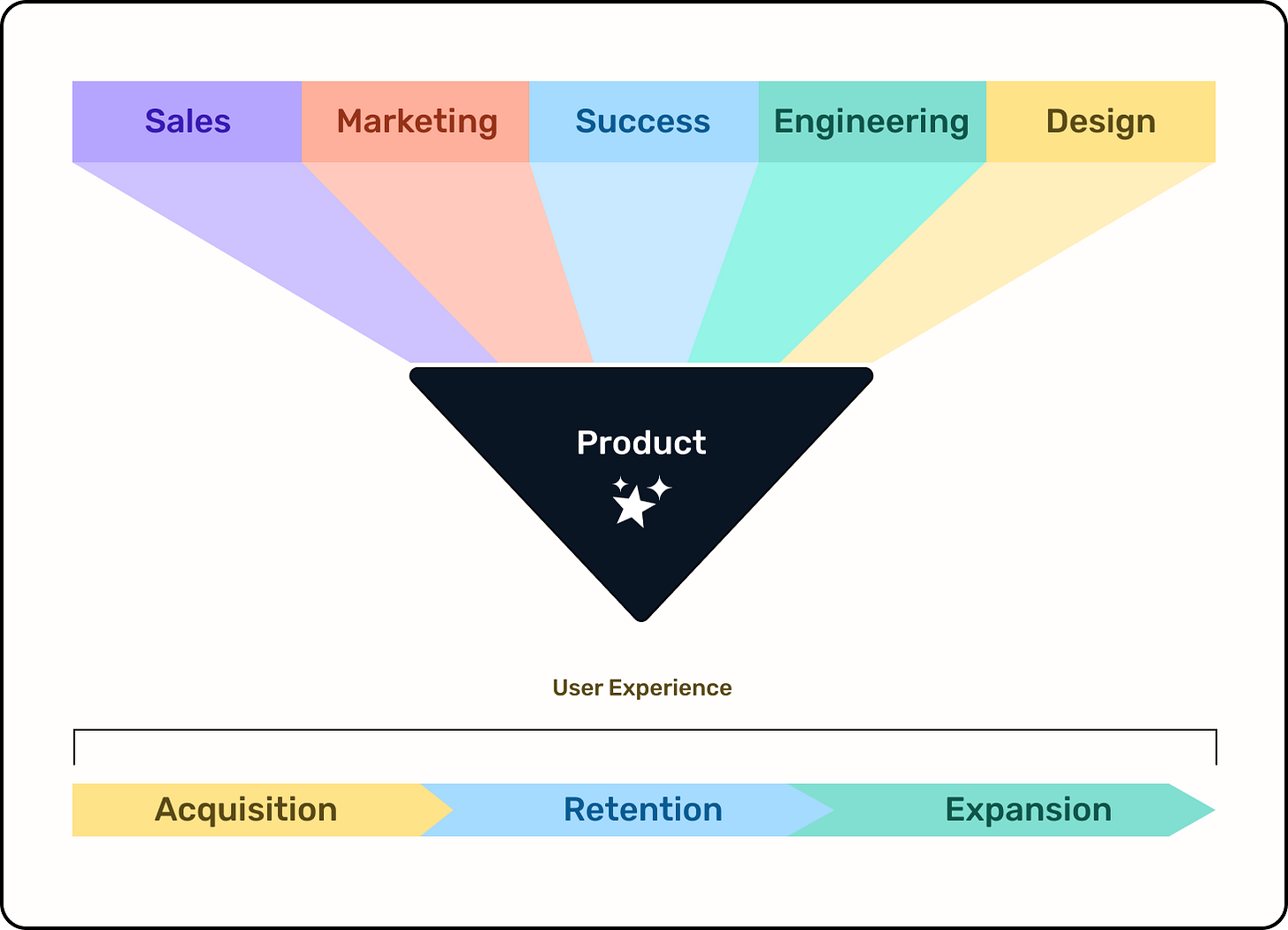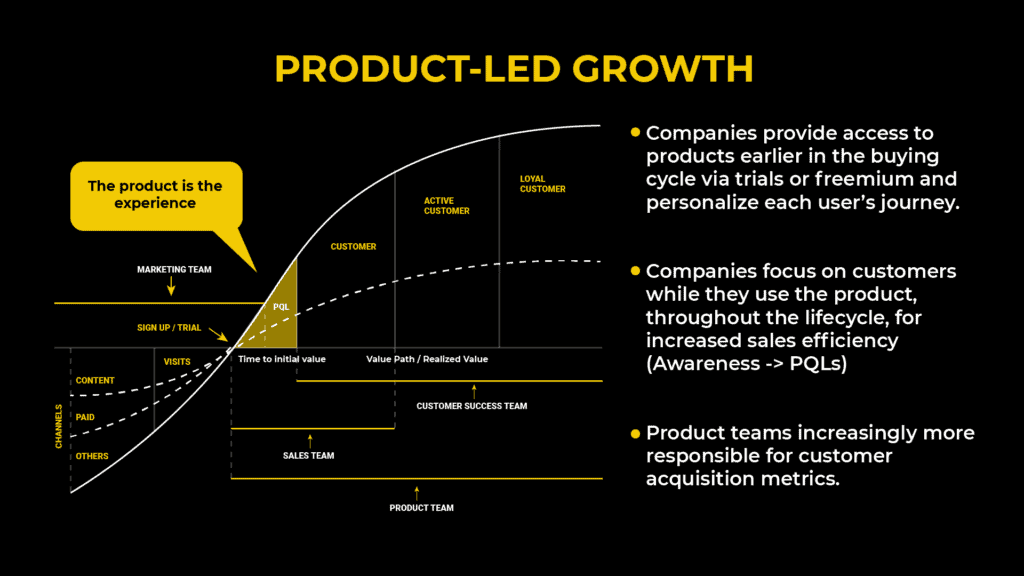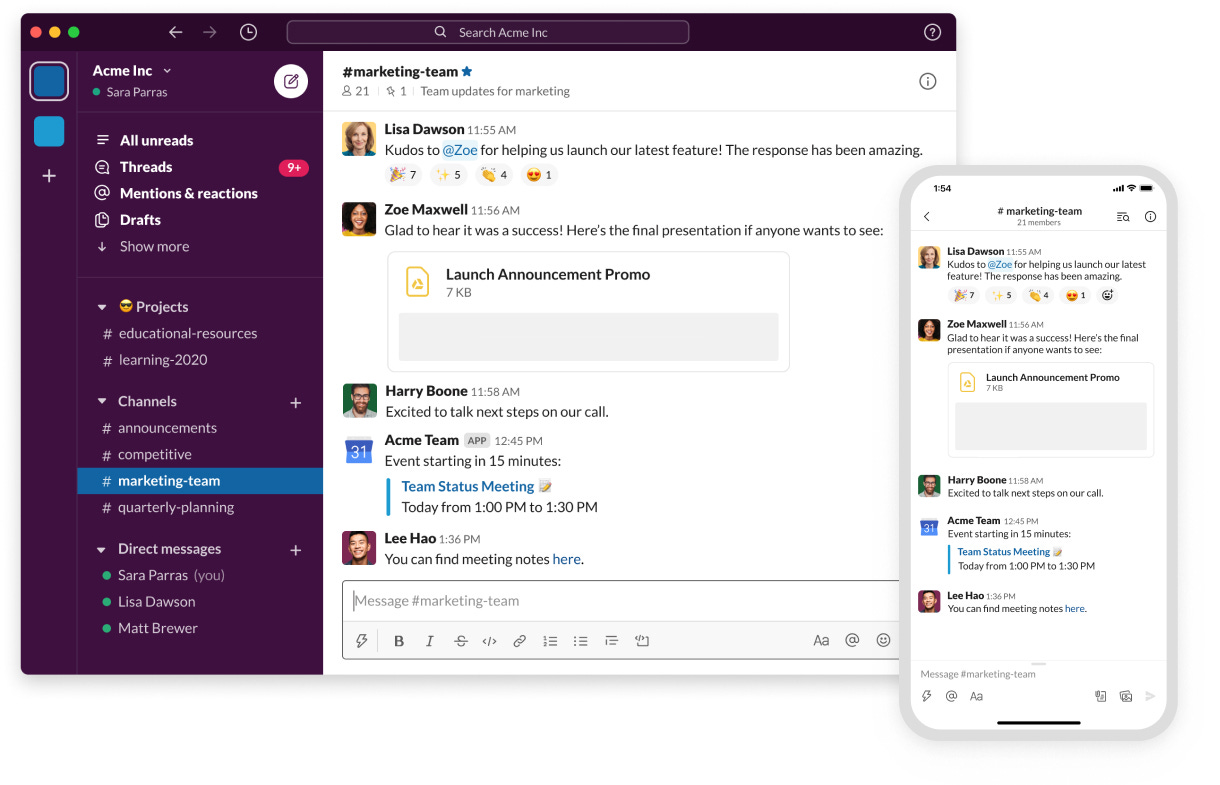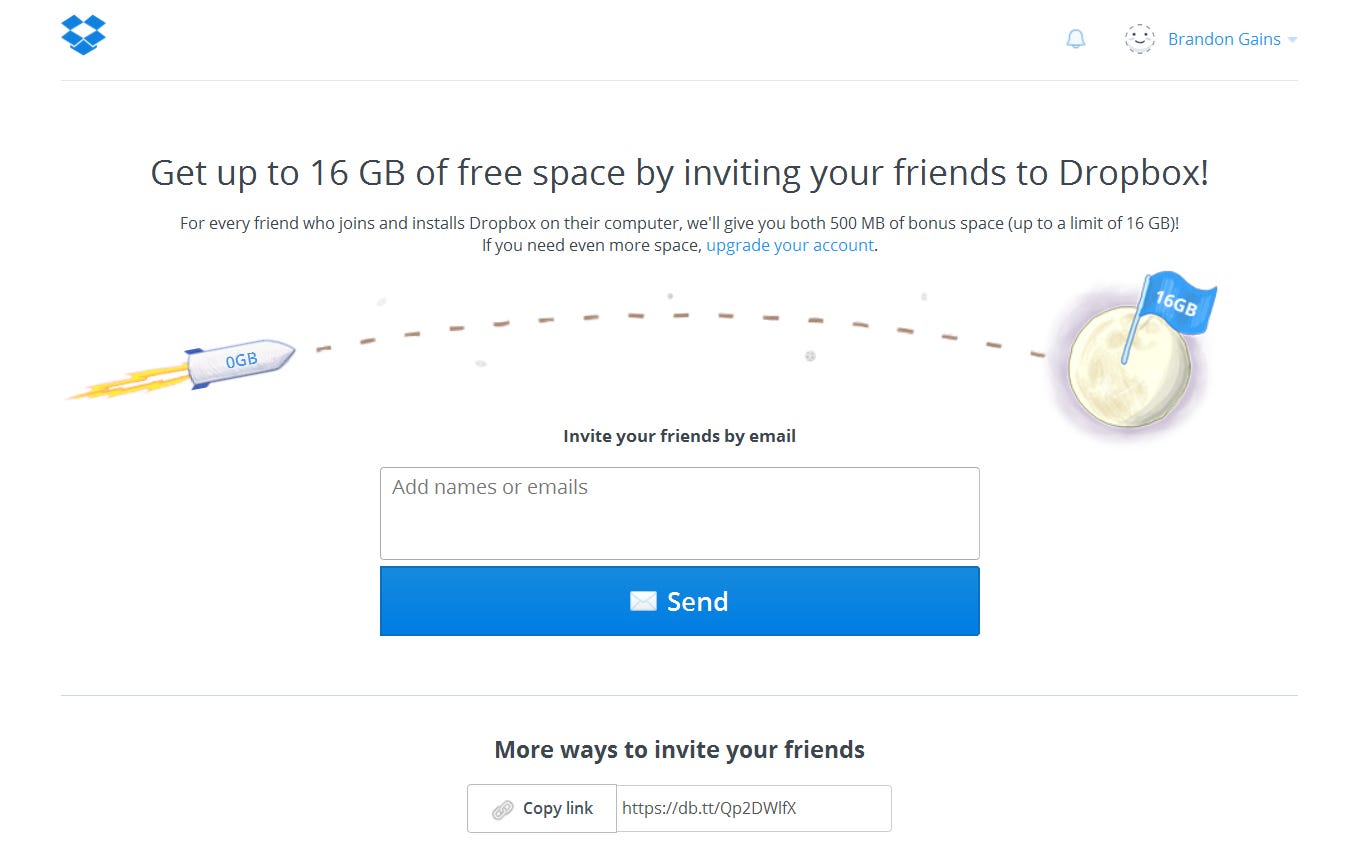Why Product-Led Growth Is a Super Strategy
Product-Led Growth (PLG) is a strategy where your product isn't just something you sell; it's your most effective salesperson.
👋 Hi, I’m Christo. Welcome to this week’s edition of the Growth Receipts newsletter. In this series I explore the most effective startup strategies, frameworks, and systems. My hope is that my ramblings offer you some value to take back to your own business.
The thing about traditional growth strategies is that they promise the moon and deliver a pebble.
Truth is, all startups are different, so applying the same sales formula, marketing plan, or other internet guru concoction to your customer acquisition strategy is not always going to work.
I’ve been there myself.
Slogging through traditional marketing strategies, spending money on ads that don’t work, chasing customers who aren't really interested.
😔…shall we bang our heads against the wall together on the count of 3?
Before we do that, I would like to paint a different picture.
Imagine for a second that your product is your best salesperson. It delivers a great pitch, has all the answers, and wows customers without a flashy billboard.
It's not magic, it's better.
It's a strategy that turns your users into your marketing department.
I'm not talking about some tech-giant wizardry.
This is Product-Led Growth (PLG), and it's been around for quite some time. In fact, your favorite software likely have PLG to thank for their success.
It’s a proven growth strategy that puts your product ahead of all your other marketing and sales efforts as the loudest voice in the room.
But it’s also as transformative as it is misused.
PLG is not a one-size-fits-all solution. For many startups it can be about as useful as a screen door on a submarine.
Neither is this a death note to traditional sales and market strategies.
PLG as a strategy does however rely on exceptional user experience and product execution.
This doesn’t mean your product needs to be bug free, or full featured. It means you need to do a few little things just right. More on that later.
If done well - and I’ve seen it done well - PLG is a method that works and that scales your business without scaling your headaches.
There are 4 parts to this post, each described below:
What exactly is PLG and why should you care?
Where is the evidence that PLG worked well?
How can YOU implement a PLG strategy in your business?
What to avoid and why PLG might not work for your business.
What exactly is PLG and why should you care?
PLG can seem like a trend or buzzword depending on where you first hear about it.
It certainly has been making its way around pitch decks for a while now.
But what is it, really?
Put simply, PLG emphasizes using your product itself as the main vehicle to drive growth.
Your product stands front and center in the lead role. This allows your customers to experience the core product before being asked to invest their money.
How does this compare to the usual way of acquiring customers?
So glad you asked! Let’s review a quick comparison.
Standard Customer Acquisition Funnel
Let’s use an example of 👨 John, a potential customer of software company ABC.
John goes through a standard customer acquisition funnel:
Awareness: John becomes aware of ABC’s product through marketing campaigns or channels like social media.
Interest: John likes what he sees and develops an interest in ABC’s product. The next time he sees the product is typically by way of marketing materials or sales efforts.
Consideration: John is a savvy buyer so he compares different products, seeking information and evaluating the pros and cons.
Intent: John has done his homework and now shows a clear intent to purchase ABC’s product.
Evaluation: John assess the final product sign up options and confirms his selection.
Purchase: John completes the purchase. He parts with his money in return for a product, and he feels good about it.
In this traditional model, marketing and sales play a crucial role in guiding John through the funnel.
It’s also expected that John goes through various fragmented steps; usually by fragmented departments in ABC (the company).
PLG Strategy
Now let’s use an example of 👩 Sarah, a potential customer of software company ABC.
Sarah goes through a PLG strategy funnel:
Product Experience: Sarah is directly exposed to the product itself after a easy sign up through a freemium or trial model.
Self-Serve Onboarding: Sarah logs in, explores and learns the product on her own or through automated onboarding processes.
Engagement: Product engagement is monitored, and Sarah is prompted with in-app messages, tutorials, etc., to encourage deeper usage.
Conversion: Sarah sees the value through using the product and decides to purchase a paid version or additional features.
Expansion: Ongoing product usage leads to opportunities for ABC to upsell or cross-sell Sarah.
As we can see in the PLG strategy the product is the core of the experience.
Sarah is encouraged to try and explore the product, and the decision-making process is guided by her direct experience with the product.
Where Does PLG Shine?
There are 5 core areas where a PLG strategy can benefit your business.
Focus. Traditional funnels rely heavily on marketing and sales, while PLG emphasizes the product experience.
Speed. PLG can often lead to quicker conversions. As we saw above, Sarah is able to directly interact with the product.
Cost. This is a big one for smaller or bootstrapped startups. As you will be relying more on the product itself rather than expensive marketing and sales efforts, you reduce customer acquisition costs.
Personalization. PLG allows for more personalized experiences, guided by user behavior within the product. There is a lot less guess work involved when you have hard data that shows you exactly how users are interacting with your product.
Scalability. This is another big one for early stage startups and especially for SaaS. PLG is far more scalable as it can reach a wide audience without extensive sales efforts.
What I like about PLG as a strategy, is that it democratizes access to your product, breaking down the barriers and letting users see the value with their own eyes.
Way less take-our-word-for-it sales pitches.
This is more about trust, transparency, fostering customer loyalty, and letting your product speak for itself.
It's about growing at scale without multiplying your sales and marketing headaches.
This diagram does a great job showing where and how PLG fits into your acquisition strategy [source].
Where Is The Evidence That PLG Worked Well?
I have a rule for when I haven’t seen an example of a strategy, framework, or system working in the wild.
I don’t write about it.
And if I do, I save that for the Thoughts section of the Growth Receipts site.
With PLG it’s no different.
But, to be frank, it’s easy to find examples where this strategy has been a huge success. Let’s focus on 2.
Slack
Slack’s app interface, pre 2023 redesign. [Source]
If PLG ever needed an ambassador, Slack would be the poster child chosen for the role.
They released their first public product in February 2014 and by 2019 they had 12 million users on the platform.
They didn't just grow; they exploded. 🚀
For maybe the first time we saw how offering something for nothing could pay off big time.
And because we’re all above conversions; there are over 6 million users in paid Slack organizations.
Slack's approach to PLG offers an interesting study in how a software company can achieve remarkable scaling by focusing on the product as the main growth driver.
I want to highlight a few of the things they did right which made PLG such a huge success for them.
Keep in mind this is all possible because Slack ensured that the user experience of their product was as frictionless as possible. They launched with a solid product that achieved all of the things Sarah had access to in the previous chapter.
Freemium model: Users could sign up for the basic version of Slack for free. Nothing says ease of sign up like zero financial commitment. The seamless experience encouraged them to later switch to paid versions with more features.
Virality Through Collaboration: Slack's design encouraged collaboration and they built a Direct Network Effect. Inviting others is easy, creating a viral loop where new users would, in turn, invite others.
Integration with Other Tools: Slack built integrations with popular tools like Google Drive, Trello, GitHub, etc. A value added for the users and a widened of audience base for Slack.
Customer Feedback Loop: Slack was able to finely tune the product by being particularly attentive to initial user feedback to understand their needs. Data driven decision making also played a big role here.
Inbound Marketing and Education: By investing heavily in content marketing, tutorials, webinars, etc., to educate potential users, they saw increased user adoption and also retention.
To summarize, Slack's PLG strategy revolved around building a superior product that users loved and could easily share with others.
Dropbox
Dropbox’s referral page. [Source]
The ol’ referral wizard.
Dropbox used many of the same tactics as Slack to drive growth early on.
One thing they did do differently that is worth pointing out is they pretty much wrote the book on successful referrals.
The program rewarded both the referrer and the referred with additional storage space. In a platform where storage space is the currency, this spread the word and increased the viral growth of the product.
Extra free storage for referring a friend? Yes please.
Dropbox's referral program helped them grow by 3900% - in just 15 months!
If you’re not impressed by that PLG magic… 😕
Since then, Dropbox has converted 18 million users to paid accounts.
Implementing a PLG Strategy In Your Business
You know what PLG is.
You’ve seen how it’s worked for other behemoths.
There’s only one thing left to do - roll up those sleeves and get down to business.
As I said at the start of the post, the exact way in which you implement a PLG strategy will depend on a lot of things. But here are some ‘musts’ that should be considered:
Step 1: Identify Your Target Audience
Who needs your product? Who would tell their family about it at the dinner table?
That's your target audience, and it pays to know them inside and out.
The better you know your audience, the better you’ll be able to tailor experiences to them. Hobbies, needs, pain points, web behavior - understand them the best you possibly can.
Step 2: Offer a Freemium or Trial Version
As a founder, this may be the painful part. Your instinct will be to charge maximum the moment a customer steps in the door. But let them experience the magic.
A freemium model or a trial version is a great, frictionless way of getting traction.
Step 3: Focus on User Experience
This is the golden ticket. The real make or break. Your product needs to be more than good; it needs to be intuitive, engaging, a delight to use.
I’ve tried PLG without this step and trust me, it’s a waste of time. You don’t get a second chance at a first impression.
"Design is not just what it looks like and feels like. Design is how it works."
Steve Jobs
Step 4: Monitor Metrics
If you can measure it, you can manage it. So track it all.
Engagement, conversions, hours used, number of times logged in, clicks on that shiny button you over engineered.
This data is your roadmap and will show you where you're going and where you need to pivot.
There are great tools to track user interaction and some like Microsoft Clarity are completely free.
Step 5: Iterate and Improve
Unfortunately your product is never perfect.
Continuously update, improve, refine. Keep the feedback loop open. Listen to your users, treat their insights like gold.
If something’s not working, fix it.
And if you do fix something, let the customer know. This is important for building loyalty and also doubles as a great service engagement strategy.
Onward to growth!
Why PLG Might Not Work
Up until now, I’ve spent the entire time telling you why PLG is great.
Now, I’m going to tell you to hold the phone.
Before you start reorganizing tasks list and buying extra servers for the users you’re about to onboard, there are some things I need to mention.
As with all good strategies there are some gotchas, pitfalls, potholes, hurdles, walls…
Anyway…😑
Let’s unpack a few now.
Product Suitability
The square peg doesn't always fit into the round hole.
As we know, PLG relies on product usage to serve as the primary driver of user acquisition, retention, and expansion.
If any one of those 3 outcomes are hindered, the chinks in the armor will show.
Here are some cases where a PLG strategy might not work well:
Complexity. If a product requires extensive training, customization, or deep technical knowledge to be properly utilized.
Regulation. Industries that have strict regulations, such as healthcare, finance, or government.
High Niche. Products that serve a very specific and limited market. If the target audience is small, the viral effects upside is limited.
Upfront Investment. If your product requires significant upfront capital to provide (e.g., costly hardware components), this approach might not be feasible.
Privacy / Security Concerns. If a product requires access to sensitive or personal information, users might feel better with a human in the loop.
Enterprise. Some large enterprises require a level of customization, integration, and alignment with existing systems.
Physical Products: These generally tend to lack the ability to be easily distributed, updated, and adopted.
Know your product; know your audience.
As a general rule of thumb, PLG shines in the tech world, where products can be shared and tested at scale. SaaS companies, mobile apps, online platforms – these are the realms where PLG thrives.
Poor Implementation
Story time…
A few years ago we built a software solution in a fairly niche market.
We launched, got some users. And lost some users.
The problem was in our implementation. There was effectively no onboarding, no tutorials and no engagement with new users.
Luckily we were able to get the train back on the tracks but the lesson was a hard one to learn.
You can’t win a PLG strategy with poor execution.
PLG isn't something you slap together over a weekend.
It requires attention to detail, a focus on user experience, and continuous improvement.
The alternative will leave you with unhappy users and a tarnished reputation.
The Brian Test
When my team and I design software or plan out strategies we apply something called the Brian test.
Brian is a friend who is completely tech adverse and goes about his day with a very ‘old school’ mentality. You couldn’t pay Brian to use your software.
Before we test concepts or ideas on real users, we ask ‘If we put this in front of Brian, would he be able to use it? Would he get it? Would he know where to click? Would he come back tomorrow if he found value?’
Find your Brian, and impress the hell out of him.
Too Much Freemium
Free can be too free.
Yes, this is for the CTOs and Founders.
Offering too much for free can limit revenue potential. It's a balancing act between enticing and giving away the store.
If you give away all your cool stuff, what does it leave your users needing to buy?
You also get to the stage where you will be known as the ‘free product’ and there comes a point where putting a price on a product that’s synonymous with free, becomes difficult.
In various interviews (like this one), both founders of Trello have said that they made the mistake of not monetizing soon enough.
To grow, you need capital. The more users you have, the more strain on infrastructure, staff and other resources.
Be generous, but don’t risk the house.
Wrapping Up
It's a big world out there, and PLG is just one path through the wilderness.
But, it’s a path that's been very good to some of the most successful companies on the planet. And for good reason.
It's not for everyone, but for those it suits, it can be transformative.
Will this work for your product? Only you can answer that. Make the choice that fits your product, your market, your vision.
Here's to your success!
If you had any thoughts, feedback or if I can help in any way, please leave a comment below.
That’s it for today! 🎉
If you got all the way to the end, I appreciate your time a great deal, and I hope I was able to provide some value.
If this was your first Growth Receipts, please join for more startup strategies, frameworks, and systems. Or tell someone who can benefit.







